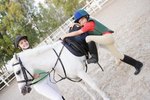
A sheep requires a lead collar for showing at livestock competitions and auctions. A rope halter is a basic and affordable tool for collaring and controlling your animal. The halter has two openings. One wraps the back of the head, and the other fits over the snout. Such a halter, with a lead rope, provides a means of holding your sheep, but training is required. Sheep will jump and fight the lead; regular practice is necessary to calm and control the animal.
Choose a Rope
Different rope sizes are effective for different animals. Choose a quarter-inch-diameter braided rope for the sheep harness. The braided rope is necessary because it splices easily when building the harness. The quarter-inch diameter is effective for goats and will work on small calves. It is a little small for large calves and larger livestock.
Prepare the Rope
Tape one end of the rope with electrical or athletic tape. Either style of tap works for securing and marking one end. Measure out 8 inches from the taped end and mark the rope with a black pen. The marking will assist in setting the nose loop on your halter.
Splice a Loop
Use a screwdriver to split the rope at the marking. Grab the end without tape and feed it through the split. Continue feeding through the split until a half-inch loop forms. Use the screwdriver to split the braids of the rope, less than 1 inch off the loop on the side without tape. Pass the taped end through the split and pull until tight. This creates a permanent nonslip loop in the rope.
Finish the Halter
Hold the taped end with your left hand. Hold the rope 6 inches above the taped end with your right hand. Push your hands together and twist, to flex the rope, and separate three strands. If the strands are stubborn, use the screwdriver to wedge them loose. Pass the tape-free end of rope through the strands. It will slide parallel to the taped end, properly executed. This forms the head loop. Pass the tape-free end back through the spliced loop to form the snout opening. The halter is ready for a sheep's head.
References
Resources
Photo Credits
-
Jupiterimages/Pixland/Getty Images
Writer Bio
Zach Lazzari is a Montana based freelance outdoor writer and photographer. You can follow his work at bustedoarlock.com.



